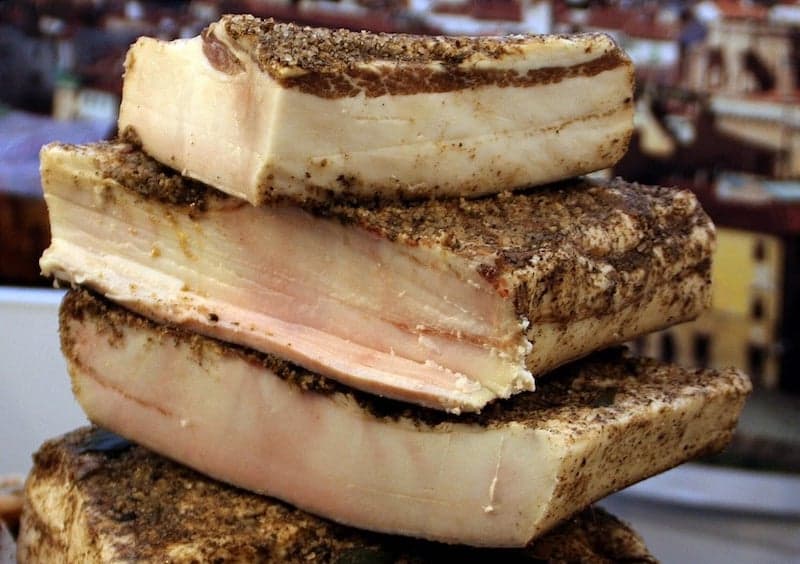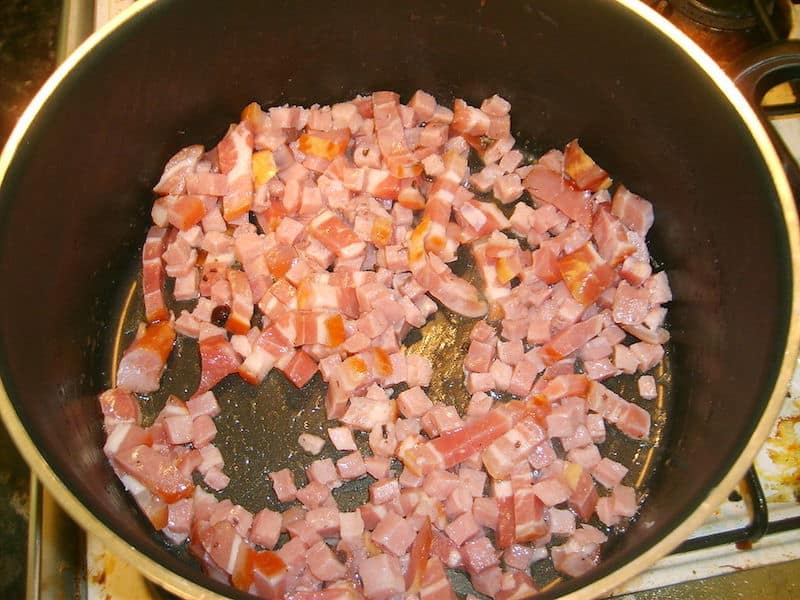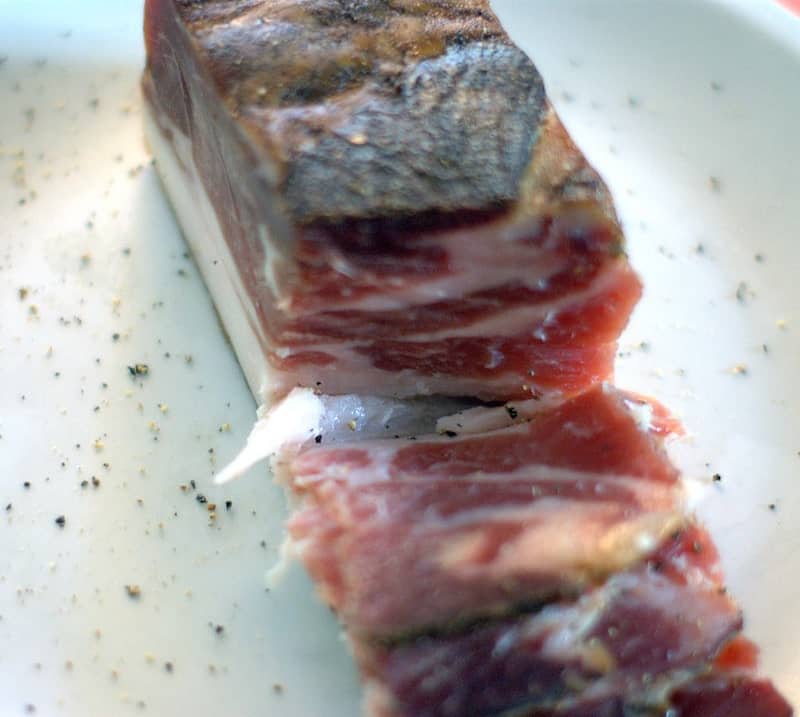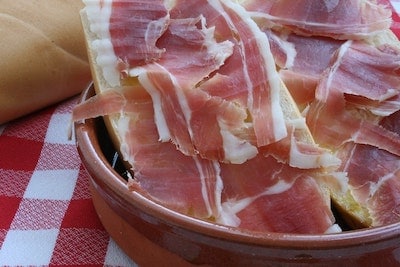Best Guanciale Substitute: Alternatives to Consider
Guanciale is a fatty and richly salted Italian cured meat made from pork cheeks. It’s a common ingredient in pasta dishes.
The problem is, real guanciale isn’t that easy to find in many areas of the US. In fact, it was even prohibited by the FDA back in the 1970s. Although the ban has been lifted, guanciale hasn’t gained its popularity back fully and remains a pretty rare import.
For this reason, you may wonder what could make a good guanciale substitute, and I’ve got the answer. Italian dry-cured meats, such as pancetta or prosciutto, make the best guanciale alternative. However, bacon and speck can also replace guanciale in many recipes.
I’ll share the best guanciale substitute options in this guide and compare them to the original pork product. Additionally, I’ll explain what exactly makes a good guanciale alternative so that you can improvise on your own. Read on to find out how to make authentic Italian pasta without using guanciale.
What Makes a Good Substitute for Guanciale?
To determine what makes a good guanciale alternative, you should first understand how it’s different from other meat types.
Guanciale has a distinct pork taste that is very salty and fat. On the other hand, the best guanciale has a velvety texture, melts in the mouth, and goes well with just about any food.
Usually, it’s thinly sliced, though you can find guanciale in large uncut pieces too. Sometimes, sage, rosemary, thyme, fennel, garlic, and red pepper are used to give the meat more taste undertones.
As guanciale isn’t smoked but is cured (so it doesn’t have to be cooked). It has a mild smell of salted meat without any smoky flavor.
A good substitute must mimic most of the guanciale flavor and texture characteristics. It should be tender and fatty pork with a melting texture.
The perfect guanciale substitute shouldn’t be dry or too lean, though some may intentionally go for a healthier option. Using the same herbs as are typically used for guanciale may enhance the similarity of a substitute.
You may think that many types of meat feature these characteristics. But the core objective is to find meat that isn’t smoked.
What Can I Substitute for Guanciale?
Now, let’s look at the most popular guanciale alternatives and their similarities and distinctions with the original.
Pancetta
Pancetta is a type of Italian salty cured meat. It’s made from pork belly and is very rarely smoked.
Smoked pancetta is called affumicata, and I advise avoiding it as a guanciale alternative, though the meat itself is delicious. Pancetta affumicata is similar to smoked bacon but is even saltier, thus very different from guanciale.
The types of pancetta that make a good substitute for guanciale are arrotolata and tesa (you can use these in dishes like pasta carbonara). The former is a piece of meat rolled in a log, while the latter is a slab of meat.
However, the preparation process and the result are the same. Sometimes, pancetta is available pre-sliced, often shaped as tiny cubes, though we don’t recommend buying it as the quality is often questionable.
Generally, the same herbs are used for pancetta as for guanciale – garlic, pepper, and thyme, enhancing the similarity with guanciale.
Overall, pancetta is one of the best guanciale alternatives as long as it isn’t smoked. Some recipes, such as pasta alla gricia, may suffer from the lack of nutty notes of guanciale. But in most cases, you won’t even notice the difference.
Bacon
Bacon is a broad concept. In the UK, it’s a piece of pork back, either cured or smoked. In the US, bacon usually refers to slices of smoked pork belly. Finally, Canadian bacon is a cooked, cured, and smoked piece of pork loin.
Thus, bacon may either make a significant or completely unsuitable substitute for guanciale, depending on the preparation method.
The good thing is, bacon generally has a similarity to guanciale’s fatty, melting texture and typically comes thinly sliced. It’s also less salted than traditional guanciale, which may be an advantage if you’re concerned about your sodium intake. Cooked bacon is also crispier than guanciale.
So, unsmoked cured bacon makes a good guanciale alternative in many dishes if you want something less salty and crisper. If you can only find smoked bacon, try blanching it for some minutes to slightly reduce the flavor intensity.
Prosciutto
Prosciutto is yet another traditional Italian cured meat. It’s often sold as a whole pork leg or thinly sliced and may be either cured or cooked (prosciutto cotto).
Cured prosciutto makes a better guanciale substitute than the cooked version as it’s saltier and has a more similar texture. Just like guanciale, prosciutto is very salty and tender, melting in the mouth.
The main difference between guanciale and prosciutto is the fat content. Prosciutto mainly consists of meat with only thin streaks of fat, whereas guanciale is made from one of the fattest pork parts. Consequently, prosciutto is less creamy and smooth than guanciale.
In addition, it dries quickly and doesn’t give as much juice during cooking. But despite a very different fat content, prosciutto is an even better guanciale alternative than pancetta.
Furthermore, it has a lower calorie and fat content.
Speck
Speck is lightly smoked and cured pork belly. In Germany, ‘speck’ refers to pork fat that may have no meat in it, though Italian speck is leaner than guanciale.
Italian speck is similar to prosciutto as it’s made from the same cut. The main difference is the denser texture and slightly smoky flavor.
Unlike guanciale, which is often seasoned with thyme, pepper, and garlic, speck is usually prepared using bay leaf and juniper. As a result, speck tastes more intense than prosciutto, about on the same level as guanciale.
Although speck isn’t an ideal guanciale alternative due to its smokiness, it also offers a tender, fatty texture and is very salty.
These two types of Italian meat taste very distinct, but speck may be an even better option for some recipes. It’s best to try it out and judge for yourself.
Lardo
Lardo is an Italian delicacy made from the fatback of pigs, primarily seasoned with rosemary and other spices, then aged.
It has a silky texture and a subtle, aromatic pork flavor. While guanciale boasts meaty streaks within its fat, lardo is predominantly fat, which can provide a creamy texture to dishes.
In recipes that demand a rich, unctuous pork essence, such as pasta sauces or spreads, lardo can be a great substitute.

Since it melts easily, it’s especially effective in dishes that benefit from a smooth, fatty component. However, it won’t provide the same meaty chew that guanciale does.
When using lardo, it’s essential to remember that its richness might make the dish heavier, so adjustments in quantity might be necessary.
Chorizo
Chorizo is a spicy Spanish or Mexican sausage made from ground pork seasoned with a blend of spices, most notably smoked paprika. Its rich red hue and robust flavor make it stand out in dishes.
As a guanciale substitute, chorizo can bring a vibrant and spicy twist, particularly in recipes where a kick of heat would be welcomed.

The Spanish variety is cured and can be sliced, while the Mexican version is typically sold fresh and needs to be cooked.
Though chorizo does not have the same fatty texture as guanciale, its powerful flavor can compensate.
In pasta dishes or stews that use guanciale as a flavor base, chorizo can introduce a unique dimension, turning the recipe into a fusion of tastes.
Salt Pork
Salt pork is made from pork belly, similar to bacon but without the smokiness. It’s heavily salted and often used in traditional American dishes to add depth and a savory punch.
The high salt content and meaty texture make it a decent substitute for guanciale, especially in recipes where the latter’s unique flavor doesn’t need to be at the forefront.

As with guanciale, salt pork can be diced and rendered to release its fats, which can be used as a flavorful base for various dishes. However, due to its pronounced saltiness, it’s crucial to adjust the seasoning of the dish to prevent it from becoming overly salty.
In recipes like Carbonara or Amatriciana, salt pork can evoke a similar mouthfeel and richness, though the dish’s flavor profile may shift slightly.
In Summary
Hopefully, this guide has inspired you to try other Italian cured meats as a guanciale substitute. Possibly, you’ll even find an alternative that tastes better and is more accessible in US stores.
But, of course, any recipe can be altered to your preferences, and there’s nothing wrong with experimenting with different types of meat in your favorite pasta dish.











